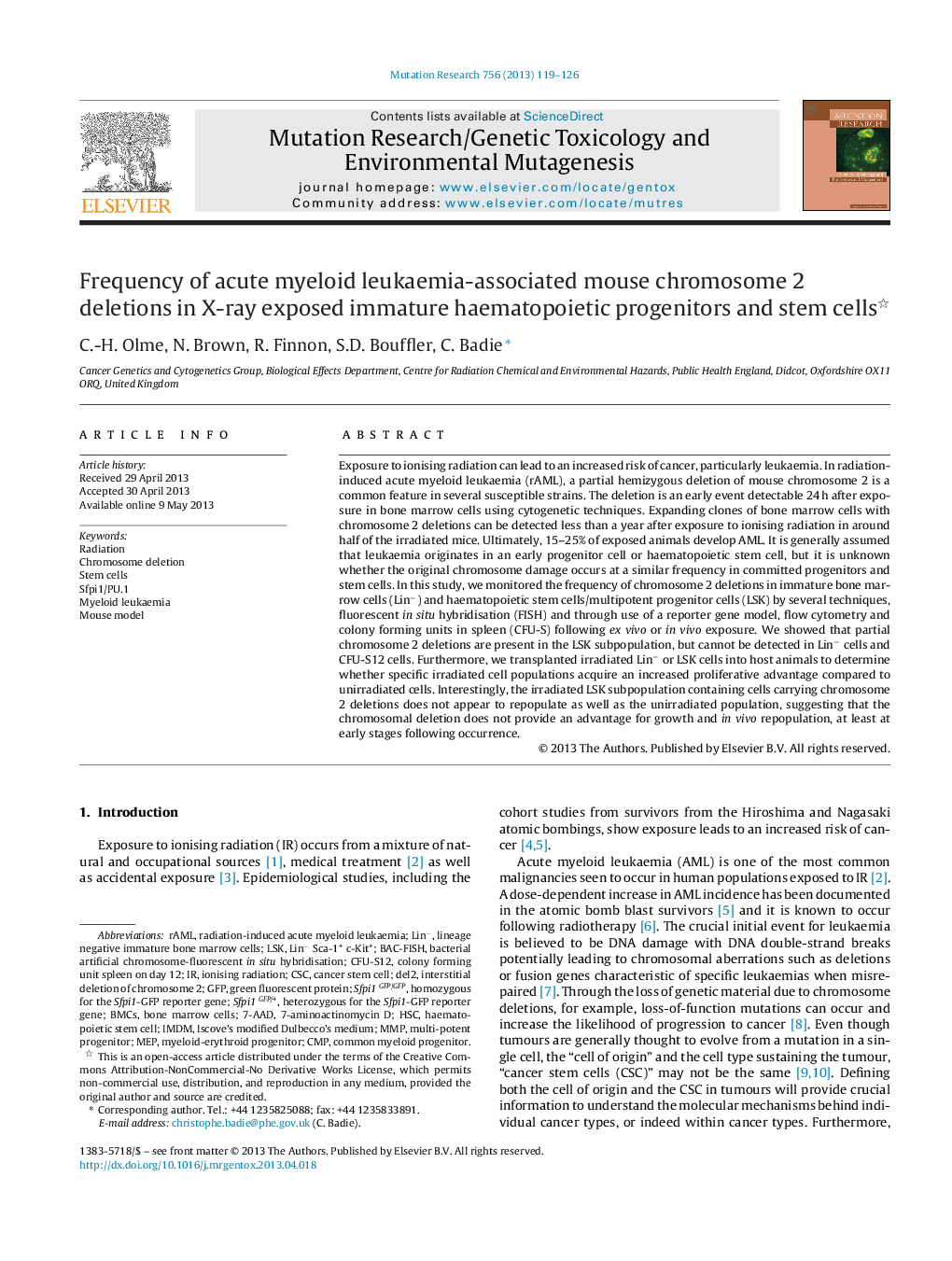| کد مقاله | کد نشریه | سال انتشار | مقاله انگلیسی | نسخه تمام متن |
|---|---|---|---|---|
| 8456510 | 1548603 | 2013 | 8 صفحه PDF | دانلود رایگان |
عنوان انگلیسی مقاله ISI
Frequency of acute myeloid leukaemia-associated mouse chromosome 2 deletions in X-ray exposed immature haematopoietic progenitors and stem cells
ترجمه فارسی عنوان
فراوانی حذف های کروموزوم 2 موش صحرایی مبتلا به لوسمی حاد در پیش آگهی های پیش آگهی نابالغ و سلول های بنیادی
دانلود مقاله + سفارش ترجمه
دانلود مقاله ISI انگلیسی
رایگان برای ایرانیان
کلمات کلیدی
BMCsLin−7-aminoactinomycin D7-AADLSKIMDMCSCCMPMEPGFPMMPHSCIscove's modified Dulbecco's medium - Medculus Dulbecco اصلاح شده Iscove استionising radiation - تابش یونیزهChromosome deletion - حذف کروموزومhaematopoietic stem cell - سلول بنیادی خون شناسیStem cells - سلول های بنیادیBone marrow cells - سلول های مغز استخوانcancer stem cell - سلولهای بنیادی سرطانیMyeloid leukaemia - لوسمی میلوئیدMouse model - مدل موشRadiation - پرتوgreen fluorescent protein - پروتئین فلورسنت سبزcommon myeloid progenitor - پیوند پروستات ملودی مشترک
موضوعات مرتبط
علوم زیستی و بیوفناوری
بیوشیمی، ژنتیک و زیست شناسی مولکولی
تحقیقات سرطان
چکیده انگلیسی
Exposure to ionising radiation can lead to an increased risk of cancer, particularly leukaemia. In radiation-induced acute myeloid leukaemia (rAML), a partial hemizygous deletion of mouse chromosome 2 is a common feature in several susceptible strains. The deletion is an early event detectable 24Â h after exposure in bone marrow cells using cytogenetic techniques. Expanding clones of bone marrow cells with chromosome 2 deletions can be detected less than a year after exposure to ionising radiation in around half of the irradiated mice. Ultimately, 15-25% of exposed animals develop AML. It is generally assumed that leukaemia originates in an early progenitor cell or haematopoietic stem cell, but it is unknown whether the original chromosome damage occurs at a similar frequency in committed progenitors and stem cells. In this study, we monitored the frequency of chromosome 2 deletions in immature bone marrow cells (Linâ) and haematopoietic stem cells/multipotent progenitor cells (LSK) by several techniques, fluorescent in situ hybridisation (FISH) and through use of a reporter gene model, flow cytometry and colony forming units in spleen (CFU-S) following ex vivo or in vivo exposure. We showed that partial chromosome 2 deletions are present in the LSK subpopulation, but cannot be detected in Linâ cells and CFU-S12 cells. Furthermore, we transplanted irradiated Linâ or LSK cells into host animals to determine whether specific irradiated cell populations acquire an increased proliferative advantage compared to unirradiated cells. Interestingly, the irradiated LSK subpopulation containing cells carrying chromosome 2 deletions does not appear to repopulate as well as the unirradiated population, suggesting that the chromosomal deletion does not provide an advantage for growth and in vivo repopulation, at least at early stages following occurrence.
ناشر
Database: Elsevier - ScienceDirect (ساینس دایرکت)
Journal: Mutation Research/Genetic Toxicology and Environmental Mutagenesis - Volume 756, Issues 1â2, 30 August 2013, Pages 119-126
Journal: Mutation Research/Genetic Toxicology and Environmental Mutagenesis - Volume 756, Issues 1â2, 30 August 2013, Pages 119-126
نویسندگان
C.-H. Olme, N. Brown, R. Finnon, S.D. Bouffler, C. Badie,
